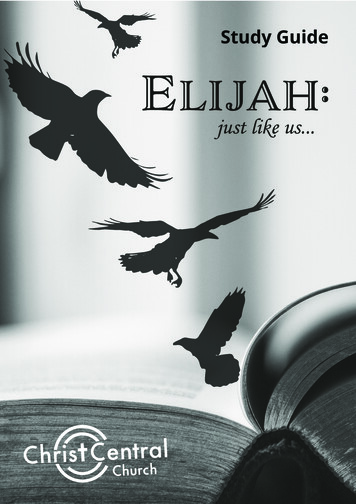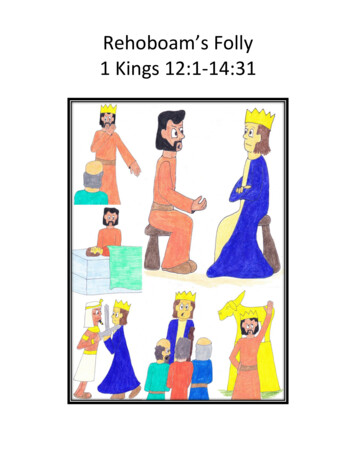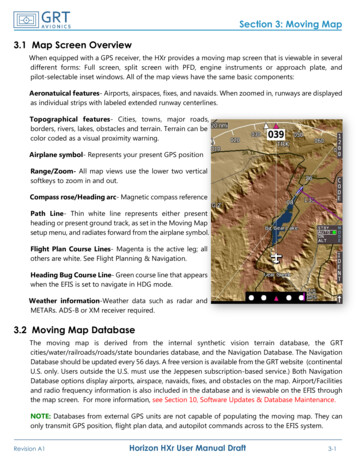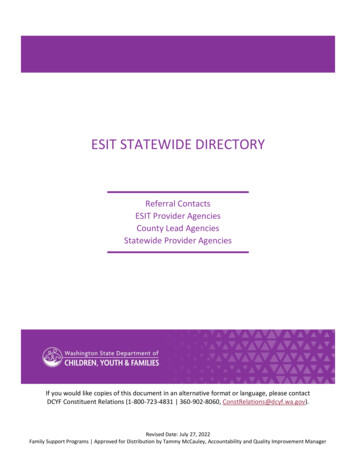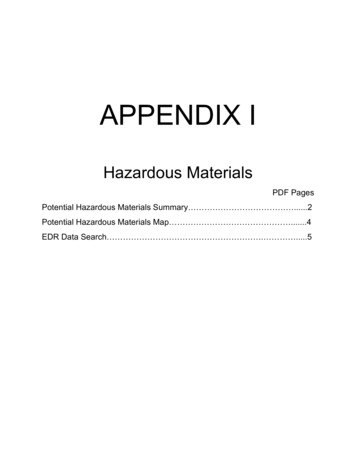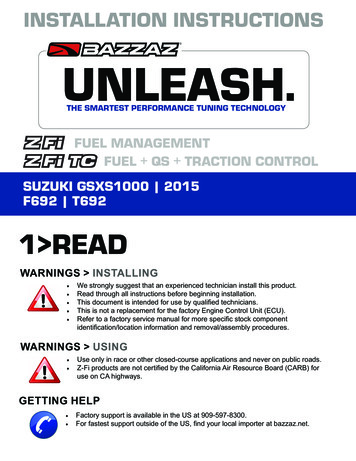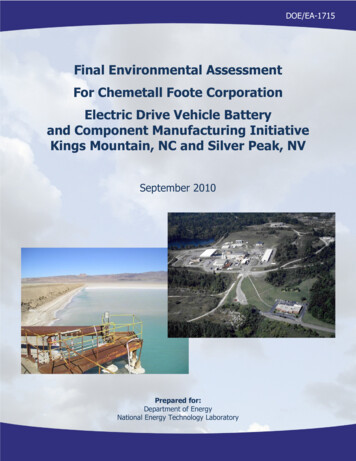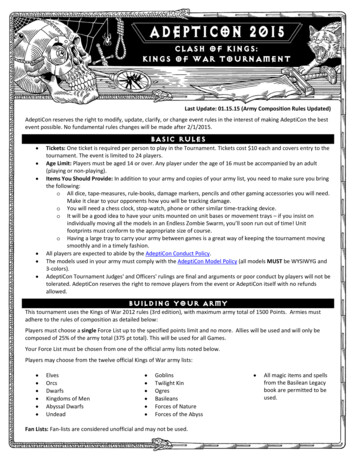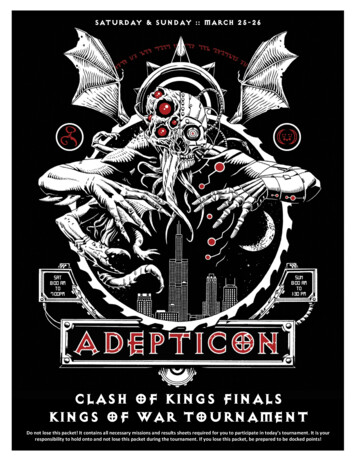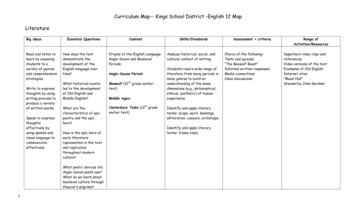
Transcription
Curriculum Map-- Kings School District -English 12 MapLiteratureBig ideasRead and listen tolearn by exposingstudents to avariety of genresand comprehensionstrategies.Write to expressthoughts by usingwriting process toproduce a varietyof written works.Speak to expressthoughtseffectively byusing spoken andvisual language tocommunicateeffectively.Essential QuestionsHow does the textdemonstrate thedevelopment of theEnglish language overtime?Origins of the English Language:Anglo-Saxon and MedievalPeriods.What historical eventsled to the developmentof Old English andMiddle English?Beowulf (12th grade anchorWhat are thecharacteristics of epicpoetry and the epichero?Canterbury Tales (12th gradeHow is the epic hero ofearly literaturerepresented in the textand replicatedthroughout modernculture?What poetic devices didAnglo-Saxon poets use?What do we learn aboutmedieval culture throughChaucer’s pilgrims?1ContentAnglo-Saxon Period:text)Middle Ages:anchor text)Skills/StandardsAnalyze historical, social, andcultural context of setting.Students read a wide range ofliterature from many periods inmany genres to build anunderstanding of the manydimensions (e.g., philosophical,ethical, aesthetic) of humanexperience.Identify and apply literaryterms: scops, wyrd, kennings,alliteration, caesura, archetype.Identify and apply literaryterms: frame tales,Assessment criteriaChoice of the following:Tests and quizzes―The Beowulf Boast‖Informal written responsesMedia connectionsClass discussionsRange ofActivities/ResourcesSuperhero video clips andreferencesVideo versions of the textExamples of Old EnglishInternet sites―Mead Hall‖Grendel by John Gardner
Curriculum Map-- Kings School District -English 12 MapBig ideasEssential QuestionsContentRenaissance literature:Read and listen tolearn by exposingstudents to avariety of genresand comprehensionstrategies.Write to expressthoughts by usingwriting process toproduce a varietyof written works.Speak to expressthoughtseffectively byusing spoken andvisual language tocommunicateeffectively.How does Hamlet fit theprototype of aShakespearean tragichero?What family dynamicsare reflected within theplay?Which outcomes of theplay are justice andwhich are tragic waste?How do minor charactersfunction to enhanceHamlet’s moral stature?How do we assign moralculpability tocharacters?How does tone conveymeaning?What qualities doesHoratio possess thatmake a good friend?What qualities must agood friend possess?Many of the characters2HamletSkills/StandardsStudents read a wide range ofliterature from many periods inmany genres to build anunderstanding of the manydimensions (e.g., philosophical,ethical, aesthetic) of humanexperience.Identify irony, theme, tone,soliloquy, flashback, imagery,allusions, style, foreshadowing,comic relief, and suspense.Assessment criteriaChoice of the following:Tests and quizzesInformal written responsesMedia connectionsClass discussionsRange p culture connections
Curriculum Map-- Kings School District -English 12 MapBig ideasEssential QuestionsContentSkills/StandardsAssessment criteriaSkills/StandardsAssessment criteriaRange ofActivities/Resourcesin Hamlet seem to takefor granted that certaindeeds demand revenge.How can people reconcilethe concept of revengewith a consistent ethicalsystem?How does appearanceversus reality play amajor theme in Hamlet?Big ideasRead and listen tolearn by exposingstudents to avariety of genresand comprehensionstrategies.Write to expressthoughts by usingwriting process toproduce a varietyof written works.Speak to express3Essential QuestionsHow does the literatureof the period reflectcultural and philosophicaltrends?What are thecharacteristics ofRomantic literature?Macbeth is also an option forthis literary period.ContentRomantic PeriodAny of the following:Rime of the Ancient MarinerFrankensteinRomantic poetryAnalyze historical, social, andcultural context of setting.Students read a wide range ofliterature from many periods innumerous genres to build anunderstanding of the manydimensions (e.g., philosophical,ethical, aesthetic) of humanexperience.Tests and quizzesLiterary responsesProjectsRange ofActivities/ResourcesThe 5 I’s (characteristics ofRomantic literature):Imagination, Inspiration,Intuition, Idealism, andIndividualismRead aloud/listenMedia connections
Curriculum Map-- Kings School District -English 12 MapBig ideasEssential QuestionsContentSkills/StandardsAssessment criteriaEssential QuestionsContentSkills/StandardsAssessment criteriaRange ofActivities/Resourcesthoughtseffectively byusing spoken andvisual language tocommunicateeffectively.Big ideasRead and listen tolearn by exposingstudents to avariety of genresand comprehensionstrategies.How is satire used toeffect social change?Restoration/18th CenturySatire:What techniques doesSwift use to achievesatire?Jonathan Swift’s “A ModestProposal”Write to expressthoughts by usingwriting process toproduce a varietyof written works.What are thedifferences betweensatire and parody?Speak to expressthoughtseffectively byusing spoken andvisual language tocommunicate4Examine an author’s implicit andexplicit philosophicalassumptions and beliefs about asubject.Recognize and differentiatecharacteristics of subgenres,including satire, parody andallegory, and explain how choiceof genre affects the expressionof theme or topic.Evaluate ways authors developpoint of view and style toachieve specific rhetorical andaesthetic purposes (e.g.,through use of irony, tone, etc.),citing specific examples fromtext to support analysis.Tests and quizzesLiterary responsesProjectsRange ofActivities/ResourcesLord of the FliesMedia connectionsExamples of contemporarysatire
Curriculum Map-- Kings School District -English 12 MapBig ideasEssential QuestionsContentSkills/StandardsAssessment criteriaRange ofActivities/Resourceseffectively.Big ideasEssential QuestionsContentSkills/StandardsAssessment criteriaActivities/ResourcesRead and listen tolearn by exposingstudents to avariety of genresand comprehensionstrategies.What are thecharacteristics ofBildungsromanliterature?Modern Novel:Students adjust their use ofspoken, written, and visuallanguage (e.g., conventions,style, vocabulary) tocommunicate effectively with avariety of audiences and fordifferent purposes.Analyze an author’s implicit andexplicit philosophicalassumptions and beliefs about asubject.TestsQuizzesPapers/Creative WritingFantoma.comPower PointsWrite to expressthoughts by usingwriting process toproduce a varietyof written works.Speak to expressthoughtseffectively byusing spoken andvisual language tocommunicateeffectively.How does one find hisidentity in the postmodern era?How is adolescent angsttransferred into a callfor action?What is the effect ofstream of consciousnesson the development ofcharacters?The Catcher in the Rye (12grade anchor text)thExplain how voice and narratoraffect the characterization,plot and credibility.Demonstrate comprehension byinferring themes, patterns, andsymbols.Explain and analyze how thecontext of setting and author’schoice of point of view impact aliterary text.Explain techniques used by5
Curriculum Map-- Kings School District -English 12 MapBig ideasEssential QuestionsContentSkills/StandardsAssessment criteriaRange ofActivities/Resourcesauthors to develop style.Read and listen tolearn by exposingstudents to avariety of genresand comprehensionstrategies.Write to expressthoughts by usingwriting process toproduce a varietyof written works.How could Lord of theFlies be viewed as anallegorical novel?Lord of the Flies (12th gradeanchor text)What or whom do thevarious characters in thenovel symbolize?Analyze variations of universalthemes in literary texts.How does human naturelead to the rise and fallof a civilization?Recognize and differentiatecharacteristics of subgenres,including satire, parody andallegory, and explain how choiceof genre affects the expressionof theme or topic.Speak to expressthoughtseffectively byusing spoken andvisual language tocommunicateeffectively.Optional novels:All Quiet on the WesternFrontBrave New World6Examine an author’s implicit andexplicit philosophicalassumptions and beliefs about asubject.Evaluate ways authors developpoint of view and style toachieve specific rhetorical andaesthetic purposes (e.g.,symbolism), citing specificexamples from text to supportanalysis.Tests and quizzesLiterary responsesProjectsLord of the FliesMedia connections
Curriculum Map-- Kings School District -English 12 MapSelf-selection ofreading materialtailored to studentinterest enhancesthe enjoyment ofreading.How does reading forpleasure differ from thestudy of literature?Independent ReadingWhat are the benefitsof reading for pleasure?Read complex textsindependently, proficiently andfluently, sustainingconcentration, monitoringcomprehension, and when useful,rereadingPresentation/SeminarWritten WorkRead/study authorsBook talksSummariesResponses to quotationsResearch SkillsHow do we share ideasfrom what we read?Personal responsesWriting skillsLetters to the authorWriting—Literary AnalysisBig ideasEssential QuestionsWrite to expressthoughts by usingwriting process toproduce a varietyof written works.What are variousmethods to effectivelyformulate and presentideas about a piece ofliterature?Read and listen tolearn by exposingstudents to avariety of genresand comprehensionstrategiesWhat are variousmethods to analyze thepossible meaning(s) of atext?ContentLiterary textLiterary analysisSkills/StandardsProduce texts that convey amessage that is organized,coherent, sufficientlydeveloped, and rhetoricallyappropriate in support of athesis.Select appropriate quotationsand passages from the text andintegrate them in support of athesis.Write responses to literaturethat provide an interpretation,recognize ambiguities, nuances7Assessment criteriaRubric for literary analysisActivities/ResourcesReadingDiscussion and/or SocraticseminarWriting processMLA guidelines
Curriculum Map-- Kings School District -English 12 MapBig ideasEssential QuestionsContentSkills/StandardsAssessment criteriaActivities/ResourcesAssessment criteriaActivities/Resourcesand complexities and thatunderstand the author’s use ofstylistic devices and effectscreated.Select and use an appropriateorganizational structure torefine and develop ideas forwriting.Use a variety of strategies torevise content, organization andstyle, and to improve wordchoice, sentence variety, clarityand consistency of writing.Properly cite sources, using agenerally accepted citationsystem such as MLA or APA.Writing—Persuasive WritingBig ideasWrite to expressthoughts by using8Essential QuestionsWhat are variousmethods to effectivelyContentPersuasive writingSkills/StandardsProduce texts that convey amessage that is organized,Rubric for persuasive writingLetters to the editorLetters of complaint
Curriculum Map-- Kings School District -English 12 MapBig ideasEssential Questionswriting process toproduce a varietyof written works.formulate and presentideas about a piece ofliterature?Read and listen tolearn by exposingstudents to avariety of genresand comprehensionstrategiesWhat are variousmethods to analyze thepossible meaning(s) of atext?ContentSkills/Standardscoherent, sufficientlydeveloped, and rhetoricallyappropriate in support of athesis.Use a range of strategies toelaborate and persuade whenappropriate, including appeal tologic, use of personal anecdotes,examples, beliefs, expertopinions and cause-effectreasoning.Select and use an appropriateorganizational structure torefine and develop ideas forwriting.Use a variety of strategies torevise content, organization andstyle, and to improve wordchoice, sentence variety, clarityand consistency of writing.Properly cite sources, using agenerally accepted citationsystem such as MLA or APA.9Assessment criteriaActivities/Resources―Call to Action‖ pieceDebateWriting processLogic, rhetorical devicesMLA guidelines
Curriculum Map-- Kings School District -English 12 MapWriting – Personal NarrativeBig ideasWrite to expressthoughts by usingwriting process toproduce a varietyof written works.Essential QuestionsHow does one derivemeaning from personalexperiences andcommunicate it to awider audience?ContentPersonal narrative (collegeessay)What storytellingtechniques are effectivein personal narrative?Skills/StandardsCompose reflective writingsthat balance reflections byusing specific personalexperiences to draw conclusionsabout life.Assessment criteriaActivities/ResourcesRubric for personal narrativeWriting processOptional college applicationsubmission and/or communityservice projectStrategies for composing aneffective leadUse of ―show, don’t tell‖strategiesSelect and use an appropriateorganizational structure torefine and develop ideas forwriting.Use of figurative language,dialogue, and theme developmentUse a variety of strategies torevise content, organization andstyle, and to improve wordchoice, sentence variety, clarityand consistency of writing.Sharing aloud, peer responseEnglish 12 VocabularyBig ideasRead and listen to10Essential QuestionsHow is meaning derivedContentSkills/StandardsAnalyze the relationships ofAssessment criteriaTests/quizzesRange ofActivities/ResourcesPower Plus workbooks:
Curriculum Map-- Kings School District -English 12 MapBig ideaslearn by exposingstudents to avariety of genresand comprehensionstrategies.Write to expressthoughts by usingwriting process toproduce a varietyof written works.Speak to expressthoughtseffectively byusing spoken andvisual language tocommunicateeffectively.Essential Questionsfrom word patterns (e.g.,roots, prefixes,suffixes)?ContentPower Plus for the NewSATHow does an expansiveand growing vocabularybase add to a person’soverall ability tocommunicate?Skills/StandardsAssessment criteriapairs of words in analogicalstatements (e.g., synonyms andantonyms, connotation anddenotation) and evaluate theeffectiveness of analogousrelationships.Range ofActivities/ResourcesInference exercisesCritical reading exercisesNew SAT-style writing andgrammar exercisesFocused prefix, suffix, and rootpracticeUse knowledge of Greek, Latinand Anglo-Saxon roots, prefixesand suffixes to understandcomplex words.How can the meaning ofunfamiliar vocabularywords be understoodthrough context clues?Use a variety of sentencestructures and lengths (e.g.,simple, compound and complexsentences; parallel or repetitivesentence structure).11th – 12th Grade GrammarBig ideasRead and listen tolearn by exposingstudents to avariety of genresand comprehensionstrategies.11Essential QuestionsHow is grammar relatedto the message conveyedin speech and writing?ContentSkills/StandardsRevisit phrases, clauses, andsentence structure for varietyin writing.Demonstrate a command of theconventions of standard Englishgrammar and usage.Revisit pronoun, verb, andmodifier usage.Make effective choices aboutgrammar for meaning and style.Assessment criteriaCorrect usage in writingTests/quizzesRange ofActivities/ResourcesExercisesWriting responsesOn-line grammar practiceACT/SAT grammar practicePower Plus for the New SATGames, grammar hunts, etc.
Curriculum Map-- Kings School District -English 12 MapBig ideasEssential QuestionsWrite to expressthoughts by usingwriting process toproduce a varietyof written works.ContentSkills/StandardsAssessment criteriaRange ofActivities/ResourcesSkills/StandardsAssessment criteriaRange ofActivities/ResourcesUnderstand the transitivenature of usage conventions.Consult reference tools asneeded for guidance in complexusage issues.Speak to expressthoughtseffectively byusing spoken andvisual language tocommunicateeffectively.11th – 12th Grade PunctuationBig ideasRead and listen tolearn by exposingstudents to avariety of genresand comprehensionstrategies.Write to expressthoughts by usingwriting process to12Essential QuestionsHow does correct use ofcapitalization andpunctuation add to themeaning of writing?How do writers usecapitalization andpunctuation as tools toenhance communication?ContentRevisit ellipses, dashes,parentheses, quotation marks,apostrophes, semicolons, andcolons.Observe the conventionsconcerning using hyphens to joinwords.Demonstrate a command of theconventions of capitalizationand punctuation.Make effective choices aboutpunctuation for meaning andstyle.Correct usage in writingTests/quizzesExercisesWriting responsesOn-line punctuation practiceACT/SAT punctuation practicePower Plus for the New SATGames, punctuation activities,etc.
Curriculum Map-- Kings School District -English 12 MapBig ideasEssential QuestionsContentSkills/StandardsAssessment criteriaRange ofActivities/Resourcesproduce a varietyof written works.Speak to expressthoughtseffectively byusing spoken andvisual language tocommunicateeffectively.Research 11th-12thBig ideasLearn to responsiblyborrow the ideas ofothers.Students will augmenttheir understanding ofvarious topics.Students will learn tolegally report anddocument theirresearch.Essential QuestionsHow can accurateresearch enhance yourunderstanding of atopic?Research Strategies:Continue to create properly formatted works cited pages.Show a variety of sourcesWhat characteristicsand techniques areunique to specificsource types andmedia?Continue to do accurate parenthetical citations according to MLAor other stylebook guidelines.What purposes doesresearching serve inthe real world?Continue to provide an introduction to and context for quotes,properly quote sources, and properly paraphrase sourcesHow do I pick and13Skills/StandardsIncrease knowledge of MLA or other stylebook guidelines.Discern between credible and non-credible sourcesExplore various reliable databasesLearn balanced use of sourcesActivities/Resources/AssessmentTeachers will choose from the following activities:Research of topics relevant to texts read in class- Biographical information- Historical/ cultural context- Controversial topics- Critical approachesAssessment- Persuasive essays- Multi-media projects- Multi-genre papers- Speeches- Video presentations- -Research papers
Curriculum Map-- Kings School District -English 12 MapBig ideasEssential Questionsargue a side of anargument usingresearch?What ethical issuesare involved inresearching?How can I become anindependentresearcher?What various researchmethods exist?How and why should Iacknowledge multiplesides of an argument?How do I create amulti-genre researchproduct tailored to aspecific audience?Skills/StandardsContinue to utilize effective research organization strategiesEffectively pick and argue a side using researchRecognize the ethical issues present in researchDistinguish between and utilize various research methods(quantitative, qualitative,)Acknowledge opposing sides of argumentsAnticipate and addressing reader misconceptions.Core Readiness Writing StandardsSelect and refine a topic or thesis that addresses the specifictask and audience.Represent and cite accurately the data, conclusions, and opinionsof others.Establish a substantive claim, distinguishing it from alternate oropposing claims.Link claims and evidence and ensure that the evidence is relevantand sufficient to support the claims.Acknowledge competing information or arguments, defending orqualifying the initial claim as appropriate.Synthesize information from multiple, relevant sources, includinggraphics and quantitative information when appropriate, to developan accurate picture of that information.Convey complex information clearly and coherently to the audiencethrough careful selection, organization, and presentation of thecontent.Demonstrate understanding of the content by getting the keyfacts right, covering the essential points, and anticipating readersmisconceptions.Core Readiness Reading Standards14Activities/Resources/Assessment
Curriculum Map-- Kings School District -English 12 MapBig ideasEssential ssmentSummarize the ideas, events, or information in the text anddetermine the main ideas and themes.Interpret data, graphics, and words in the text, and combine theelements of information to achieve comprehension.Follow the reasoning that supports and argument or explanationand assess whether the evidence provided is relevant andsufficient.Ascertain the origin and credibility of print and online sourceswhen conducting research.Apply knowledge and concepts drawn from texts to other texts,contexts, and circumstances.Speaking and Listening StandardsPresent information and findings clearly and persuasively,selecting an appropriate format, organization, and register for thepurpose and audience.Speaking and Listening – 9th-12thBig ideas1. Speaking expressesthoughts, opinions, andideas by using goodcommunication skills togain understanding.Organization of ideasIncorporation ofdetails, statistics,and examples2. Communication is a15Essential QuestionsWhy is communicationimportant?How will speaking andlistening skills enhanceone’s life?What makescommunication clear,useful, and meaningful?Skills/StandardsComprehension and CollaborationGrades 9 and 101. Initiate and participate effectively in group discussions on grades9–10 topics, texts, and issues being studied in class.a. Prepare for discussions by reading and researching material understudy and explicitly draw on that preparation in discussions.b. Cooperate with peers to set clear goals and deadlines and toestablish roles.c. Build on essential information from others’ input by asking questionsand sharing comments that enrich discussions.d. Acknowledge the ideas and contributions of others in the group,Activities/Resources and their assessmentClass PresentationsDiscussion GroupsSocratic SeminarsClass Participation
Curriculum Map-- Kings School District -English 12 MapBig ideasprocess wherebyinformation is enclosedin a package and ischanneled andimparted by a senderto a receiver via somemedium.3. Good listening andobservation skills arestrategies to gainunderstanding ofcommunication.4. Public speaking skillsand strategies help inthe interaction ofworking effectivelywith others.5. Communication skillsand strategieseffectively presentideas and one’s self in avariety of situations.16Essential QuestionsHow does one conveymeaning verbally andnonverbally?Skills/Standardsreach decisions about the information and ideas under discussion, andcomplete the task.e. Evaluate whether the team has met its goals.2. Synthesize information presented visually or multimodality withother information presented orally, noting any discrepancies betweenthe data that emerge as a result.3. Evaluate the information conveyed and rhetoric used by a speakeror presenter, identifying logical errors in reasoning and exaggeratedor distorted evidence.Presentation of Knowledge and Ideas4. Plan and deliver relevant and sufficient evidence in support offindings and claims such that listeners can follow the reasoning,adjusting presentation to particular audiences and purposes.5. Make strategic use of digital media elements and visual displays ofdata to enhance understanding.6. Adapt speech to a variety of contexts and communicative tasks,demonstrating a command of formal English when indicated orappropriate.Comprehension and CollaborationGrades 11 and 121. Initiate and participate effectively in group discussions on grades11–12 topics, texts, and issues being studied in class.a. Prepare for discussions by distilling the evidence or informationabout the material under study and explicitly draw on that preparationin discussions.b. Cooperate with peers to set clear goals and deadlines, establishroles, and determine ground rules for decision making (e.g., informalconsensus, taking votes on key issues, and presentation of alternateviews).c. Propel conversations forward by asking questions that test theActivities/Resources and their assessment
Curriculum Map-- Kings School District -English 12 MapBig ideasEssential QuestionsSkills/Standardsevidence and by sharing findings that clarify, verify, or challengeideas and conclusions.d. Summarize accurately the comments and claims made on all sides ofan issue and determine what additional information, research, andtasks are required for the team to complete the task.e. Evaluate whether the team has met its goals.2. Integrate multiple streams of data presented through variousmediums, evaluating the reliability and credibility of each source ofinformation in order to answer questions, solve problems, or buildknowledge.3. Determine a speaker’s or presenter’s position or point of view byassessing the evidence, word choice, points of emphasis, and toneused.Presentation of Knowledge and IdeaGrades 11 and 124. Plan and deliver focused and coherent presentations that conveyclear and distinct perspectives such that the line of reasoning andsources of support are clear and alternative perspectives areaddressed, adjusting presentation to particular audiences andpurposes.5. Make strategic use of digital media elements and visual displays ofdata to enhance understanding.6. Adapt speech to a variety of contexts and communicative tasks,demonstrating a command of formal English when indicated orappropriate.17Activities/Resources and their assessment
Curriculum Map-- Kings School District -English 12 Map 2 Big ideas Essential Questions Content Skills/Standards Assessment criteria Range of Activities/Resources Read and listen to learn by exposing students to a variety of genres and comprehension strategies. Write to express thoughts by using writing process to produce a variety

